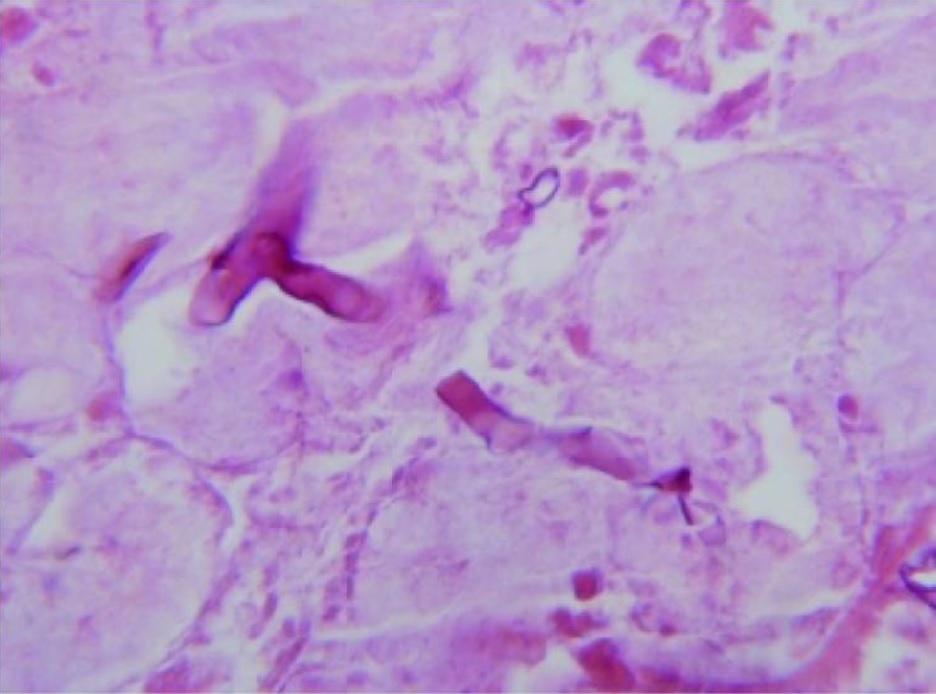Advertisement
Advertisement
Advertisement
Advertisement
Mucormycosis is an angioinvasive fungal infection caused by multiple fungi Fungi A kingdom of eukaryotic, heterotrophic organisms that live parasitically as saprobes, including mushrooms; yeasts; smuts, molds, etc. They reproduce either sexually or asexually, and have life cycles that range from simple to complex. Filamentous fungi, commonly known as molds, refer to those that grow as multicellular colonies. Mycology within the order, Mucorales. The fungi Fungi A kingdom of eukaryotic, heterotrophic organisms that live parasitically as saprobes, including mushrooms; yeasts; smuts, molds, etc. They reproduce either sexually or asexually, and have life cycles that range from simple to complex. Filamentous fungi, commonly known as molds, refer to those that grow as multicellular colonies. Mycology are ubiquitous in the environment, but mucormycosis is very rare and almost always occurs in patients Patients Individuals participating in the health care system for the purpose of receiving therapeutic, diagnostic, or preventive procedures. Clinician–Patient Relationship who are immunocompromised immunocompromised A human or animal whose immunologic mechanism is deficient because of an immunodeficiency disorder or other disease or as the result of the administration of immunosuppressive drugs or radiation. Gastroenteritis. Inhalation of fungal spores Spores The reproductive elements of lower organisms, such as bacteria; fungi; and cryptogamic plants. Anthrax can cause rhinocerebral or pulmonary mucormycosis, direct inoculation can cause cutaneous mucormycosis, and ingestion can cause gastrointestinal mucormycosis. The clinical presentation results from fungal hyphae Hyphae Microscopic threadlike filaments in fungi that are filled with a layer of protoplasm. Collectively, the hyphae make up the mycelium. Mycology invading the blood vessels, causing thrombosis Thrombosis Formation and development of a thrombus or blood clot in the blood vessel. Epidemic Typhus and tissue necrosis Necrosis The death of cells in an organ or tissue due to disease, injury or failure of the blood supply. Ischemic Cell Damage. Diagnosis is confirmed with the identification Identification Defense Mechanisms of the organism on histopathology of biopsy Biopsy Removal and pathologic examination of specimens from the living body. Ewing Sarcoma specimens. Patients Patients Individuals participating in the health care system for the purpose of receiving therapeutic, diagnostic, or preventive procedures. Clinician–Patient Relationship must be treated aggressively with antifungals and surgical resection of infected tissues.
Last updated: Oct 31, 2022
Advertisement
Advertisement
Advertisement
Advertisement
Advertisement
Advertisement
Advertisement
Advertisement
Taxonomy:
Morphology:

A microscopic view of the biopsy specimen shows several short, folded hyphae with nonseptate, broad and right-angle buddings, which are characteristic of mucormycosis.
Image: “Histopathological findings” by Baezzat SR et al. License: CC BY 2.5Mucormycosis is caused by many species within the Mucorales order, which can be classified based on the site of infection:
Mucorales are common in the environment and are found on:
Almost all infections Infections Invasion of the host organism by microorganisms or their toxins or by parasites that can cause pathological conditions or diseases. Chronic Granulomatous Disease occur in the presence of an underlying condition:
Patients Patients Individuals participating in the health care system for the purpose of receiving therapeutic, diagnostic, or preventive procedures. Clinician–Patient Relationship start with symptoms of acute sinusitis Sinusitis Sinusitis refers to inflammation of the mucosal lining of the paranasal sinuses. The condition usually occurs concurrently with inflammation of the nasal mucosa (rhinitis), a condition known as rhinosinusitis. Acute sinusitis is due to an upper respiratory infection caused by a viral, bacterial, or fungal agent. Sinusitis. Symptoms progress due to the spread of the infection to contiguous structures.

Swelling of the upper and lower lid in a patient with orbital involvement from mucormycosis
Image: “Swelling of upper and lower lid in the patient with mucormycosis” by Badiee P et al. License: CC BY 2.0Patients Patients Individuals participating in the health care system for the purpose of receiving therapeutic, diagnostic, or preventive procedures. Clinician–Patient Relationship with pulmonary disease Pulmonary disease Diseases involving the respiratory system. Blastomyces/Blastomycosis develop rapidly progressive pneumonia Pneumonia Pneumonia or pulmonary inflammation is an acute or chronic inflammation of lung tissue. Causes include infection with bacteria, viruses, or fungi. In more rare cases, pneumonia can also be caused through toxic triggers through inhalation of toxic substances, immunological processes, or in the course of radiotherapy. Pneumonia (often bilateral).
The condition causes necrotic ulcers in the gastrointestinal tract (most commonly in the stomach Stomach The stomach is a muscular sac in the upper left portion of the abdomen that plays a critical role in digestion. The stomach develops from the foregut and connects the esophagus with the duodenum. Structurally, the stomach is C-shaped and forms a greater and lesser curvature and is divided grossly into regions: the cardia, fundus, body, and pylorus. Stomach: Anatomy), which can lead to perforation Perforation A pathological hole in an organ, blood vessel or other soft part of the body, occurring in the absence of external force. Esophagitis. Signs and symptoms include:
A high index of suspicion is required to make the diagnosis.
| Organism | Mucorales | Aspergillus Aspergillus A genus of mitosporic fungi containing about 100 species and eleven different teleomorphs in the family trichocomaceae. Echinocandins |
|---|---|---|
| Characteristics | ||
| Transmission |
|
|
| Clinical | Mucormycosis:
|
|
| Diagnosis |
|
|
| Management |
|
|